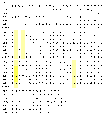

The diagram shows the conservation of cysteine residues in the major members of the CXC family of Cytokines. All the sequences can be aligned with a minimal number of deletions and insertions.
Abbreviations used are:-
IL-8 Interleukin-8
gro gro-alpha
IP-10 gamma-Interferon Protein-10
PBP Platelet Basic Protein
hPF4 human Platelet Factor 4
bPF4 bovine Platelet Factor 4
mMIP-2 murine Macrophage Inflammatory Protein 2

Platelet Factor 4 - Protein is synthesised in megakaryocytes, then transferred to platelet alpha-granules. It is secreted by platelets as a component of a chondroitin-4-sulphate-rich proteoglycan. PF4 was originally identified due to its ability to neutralise the anti-coagulant activity of heparin. PF4 binds to many glycosaminoglycans, but most strongly to heparin. PF4 is also known to be chemotactic for neutrophils, monocytes and fibroblasts, thereby implying a role in wound-healing. It also has several minor effects, including inhibition of angiogenesis and inhibition of megakaryocytopoiesis in vitro.
PBP/CTAP-III/bTG - This is a group of proteins also found in platelet alpha-granules. Connective Tissue Activating Peptide III (CTAP-III), beta-Thromoglobulin (bTG), Neutrophil Activating Peptide 2 (NAP-2) and Low Affinity Platelet Factor 4 (LAPF4) have all been shown to be proteolytic digest products of Platelet Basic Protein (PBP). It is thought that proteolytic cleavage is a method of regulation of the biological effects of these molecules, as the functions of the various proteins are different. bTG is a fibroblast chemoattractant. NAP-2 is a potent chemoattractant and activating factor for neutrphils.
gamma-IP-10 - No specific biological function has yet been assigned to gamma-Interferon Protein-10, although there is some evidence to suggest a rôle in the inflammatory response.
gro - There are at least 3 distinct human gro proteins, designated gro-alpha, -beta and -gamma. They are thought to have arisen from triplication of a single ancestral gro gene. The protein sequences are over 85% identical. The murine proteins MIP-2 and KC are thought to be homologues of different human gro isoforms. Identification of which of the reported functions of gro proteins correspond to which isoform is still to take place. gro-alpha, also called Melanoma Growth Stimulatory Activity (MGSA) has been reported to be a chemotactic and activating factor for neutrophils.
IL-8/NAP-1 - Interleukin-8, or Neutrophil Activating Peptide-1, is the most well-characterised of the chemokines. It has been shown to be produced by a great variety of cell types, and clearly has an important rôle in the inflammatory response and wound-healing. IL-8 is thought to be an inflammatory mediator, affecting a variety of cells. It is a potent chemoattractant for neutrophils, but is thought to have a lesser chemotactic effect on human blood peripheral T-cells, basophils and possibly also on melanoma cells.

John Maclean johnm@chem.gla.ac.uk
Back to Protein Crystallography